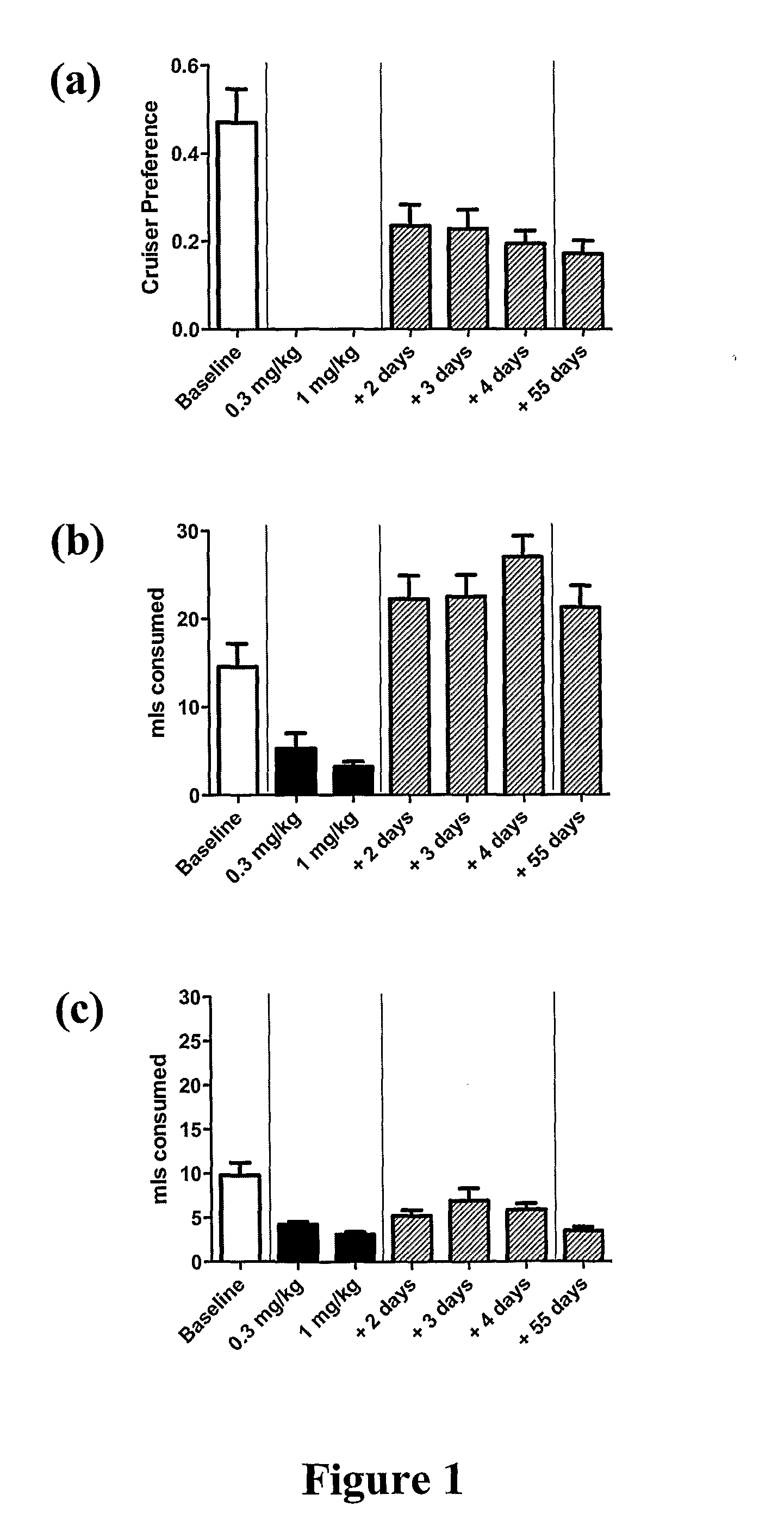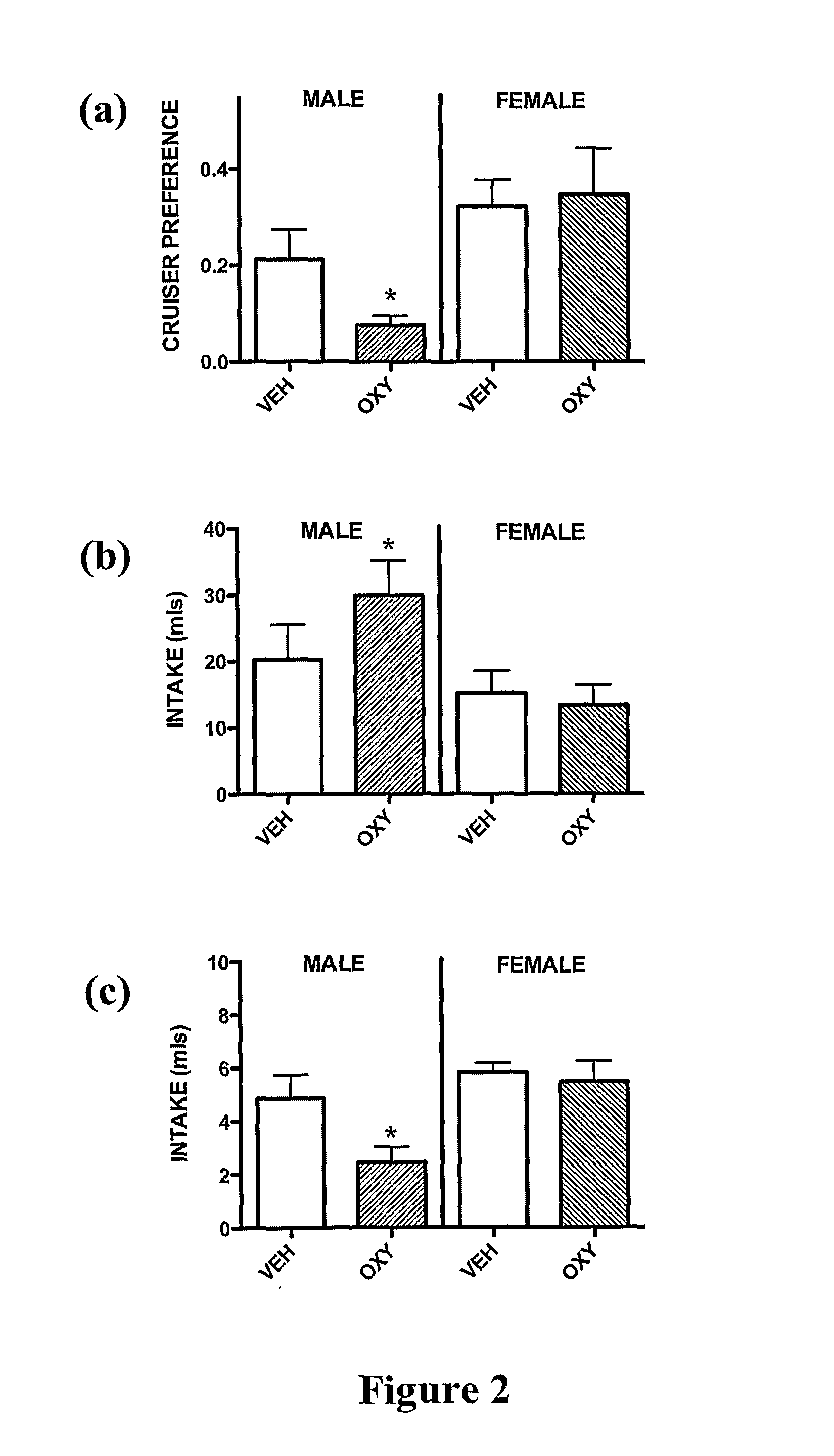Therapy and Prevention of Problem Drinking
a problem drinking and treatment method technology, applied in the field of problem drinking treatment and prophylaxis, can solve the problems of imposing a significant burden on the individual, causing problems such as problem drinking, and affecting the individual, so as to reduce the self-administration of alcohol, promote or enhance abstinence from alcohol, and reduce the effect of alcohol consumption
- Summary
- Abstract
- Description
- Claims
- Application Information
AI Technical Summary
Benefits of technology
Problems solved by technology
Method used
Image
Examples
example 1
Acute Effects of Oxytocin on Alcohol Consumption and Preference
[0202]This example demonstrates the efficacy of oxytocin therapy on alcohol consumption and preference, in an animal model of problem drinking.
Subjects
[0203]P rats (8 female and 8 male P rats) were provided by Professor Andrew Lawrence at the Howard Florey Institute, Melbourne, Australia. The animals were of adolescent age (i.e., 28 days-old) on arrival at the animal house. Animals were housed in same-sex cages at a density of 3-4 rats per cage. Over the following 2 months, animals received intermittent exposure to various alcoholic beverages in their home cages e.g., white wine, red wine, beer, Vodka Cruiser, Bacardi Breezer, but were alcohol-free for the month preceding testing.
General Procedure
[0204]Testing occurred in a lickometer apparatus. Rats were placed in a small metal cage where they have a choice of two tubes for supply of liquids, wherein the tube were designed such that every third lick at one tube delivere...
example 2
Oxytocin for Use in the Prevention of Problem Drinking
[0207]This example demonstrates the ability of oxytocin to prevent or delay alcohol intake by alcohol-naïve subjects in an animal model of problem drinking.
Subjects
[0208]P rats (8 female and 6 male P rats) of adult age (i.e., 150 days) were used in this study. Animals were maintained as described in example 1, however they received no alcohol prior to testing.
Drug Treatment
[0209]One-half of the rats (n=4 female and n=3 male) were given 10 injections of 1 mg / kg oxytocin (a single I / P injection per day for a total of 10 days). The other half of the rats received equivalent injections of placebo / vehicle lacking oxytocin. Two weeks later, the alcohol preferences of both sets of alcohol-naïve animals were tested. The same alcohol and alcohol-free solutions were employed as in example 1, and testing conditions were in the same lickometer apparatus. Testing in the lickometer (1×70 min session per day) continued for a total of 10 days du...
example 3
[0211]Treatment with oxytocin prevents subsequent alcohol preference and consumption
[0212]This example demonstrates that oxytocin is an effective preventive therapy against problem drinking in subjects who are not necessarily predisposed to problem drinking behavior, using an animal model comprising a common laboratory rat strain of Wistar rats, that show relatively high levels of alcohol intake but are not genetically selected for alcohol preference.
Subjects
[0213]Male Wistar rats (n=48) were obtained from the Animal Resource Centre (ARC), Perth, Western Australia, Australia. The animals were of early adolescent age (i.e., 21 days-old) on arrival and were young adults (i.e., 33 days-old) when oxytocin therapy commenced. The animals were housed and maintained as described in the preceding examples, except that animals were moved to individual housing during chronic exposure to alcohol.
Dosage Regimen
[0214]One-half of the rats (n=24) were administered 10 injections of 1 mg / kg oxytocin ...
PUM
| Property | Measurement | Unit |
|---|---|---|
| molecular weights | aaaaa | aaaaa |
| molecular weights | aaaaa | aaaaa |
| particle size | aaaaa | aaaaa |
Abstract
Description
Claims
Application Information
 Login to View More
Login to View More - R&D
- Intellectual Property
- Life Sciences
- Materials
- Tech Scout
- Unparalleled Data Quality
- Higher Quality Content
- 60% Fewer Hallucinations
Browse by: Latest US Patents, China's latest patents, Technical Efficacy Thesaurus, Application Domain, Technology Topic, Popular Technical Reports.
© 2025 PatSnap. All rights reserved.Legal|Privacy policy|Modern Slavery Act Transparency Statement|Sitemap|About US| Contact US: help@patsnap.com



